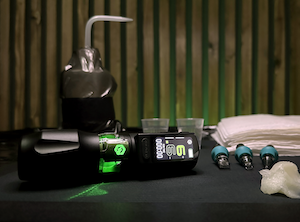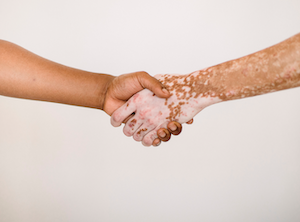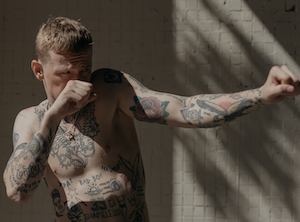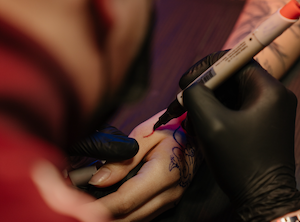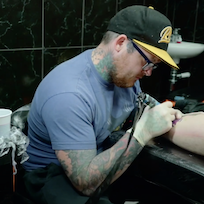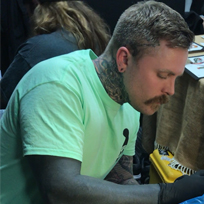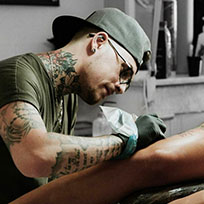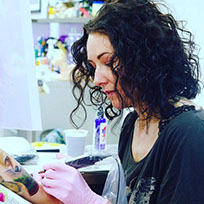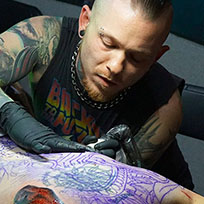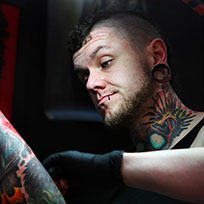Looking for your first or a new piercing? Even though piercings aren’t as permanent as tattoos, you may have some questions before taking the plunge. There are so many different locations, types, and styles. Not to mention the pain levels and healing times that vary between different types of piercings. Knowing all these factors can help you make the right decision.
Ear Piercings
Ear piercing has become a genuine trend. It is the most popular piercing with a dozen possible locations and an infinite number of jewellery combinations.

Helix:
The Helix is a trending option. It is located on the upper part of the external cartilage of the ear. It is possible to do two or even three helix piercings in this area.
This piercing isn’t the most painful if it is well done, as it is located on a relatively thin part of the cartilage and heals quite well.
Healing time: 3 to 12 months to completely heal.
Anti-Helix:
Located on the part of the Helix closest to the face, above the Tragus, the Anti-helix piercing is less common. It is also possible to have multiple piercings here, like the Helix.
It can be a little painful, as can other ear cartilage piercings; however, this part of the cartilage is also quite thin.
Unlike the Helix piercing, the Anti-helix piercing can take longer to heal as it is more exposed to bacteria.
It can therefore take between 6 to 12 months to heal. After healing, these piercings are very easy to maintain.
Rook:
The Rook piercing takes its name from the piercer who performed it for the first time, Erik Dakota, Rook being his nickname.
It is considered one of the most painful ear piercings due to the thickness of the cartilage at this level of the ear. The Rook piercing is located on the part of cartilage that forms a fold in front of the anti-helix.
The Rook is not possible on all ears; if the fold is not pronounced enough, it will not be possible to carry out this piercing.
Complete healing can take up to 12 months.
Industrial:
The Industrial piercing (or “Scaffold” piercing) is a combination of two piercings, one towards the Helix and the other towards the anti-helix, linked by a straight bar, i.e. scaffolding.
As with a Rook piercing, some people won’t be able to have an Industrial piercing, depending on the shape of your ear.
The Industrial piercing is a more painful procedure because it is essentially two piercings.
The healing of an Industrial piercing can take from 3 months to 12 months to complete recovery.
Daith:
Beyond the aesthetic aspect, the Daith would have virtues against a migraine. The Daith piercing is located at the exit of the auditory canal. In the prolongation of the anti-helix, this area is a point of acupressure practised in traditional Chinese medicine to relieve chronic headaches and migraines.
The Daith piercing is quite painful due to the thickness of the cartilage and its location, and it is one of the most painful cartilage piercings, but still bearable and very quick!
The pain after the piercing can be greater than with other piercings.
The healing of the Daith piercing takes about 6 months.
Snug:
The Snug piercing isn’t very common. This piercing is located on the same cartilage as the Rook, but lower. It can be a little painful as it passes through two layers of cartilage, but as the cartilage is thinner, it should be less painful than a Rook piercing
The Snug can take more than 12 months to heal.
Conch:
The Conch piercing is located in the middle of the ear cartilage. It can be positioned in different ways – internal or external conch – depending on the style you wish to wear.
The pain is different for everyone, but the conch piercing should not hurt more than any other cartilage piercing.
Allow 3 to 12 months for a total heal.

Tragus & Anti-Tragus:
The trendy Tragus piercing is on the piece of cartilage called the Tragus, which protects the exit of the ear canal.
The opposite of the Tragus piercing is the Anti-tragus piercing, just above the upper lobe, on a thicker part of the ear cartilage.
These piercings don’t hurt more than other cartilage piercings.
The healing time for these piercings is one of the shortest for ear cartilage due to their more protected location, averaging between 2 and 6 months.
Lobe / 2nd Lobe:
Undoubtedly the most pierced area in the world, the Earlobe piercing is the most effortless piercing to receive in terms of pain and healing time.
As the earlobe is the softest part of the ear, the pain level is very low.
If the size of your lobe allows it, it is possible to have up to 3 or even 4 piercings! The Lobe piercing is also the easiest to stretch to put plugs or tunnels in – these can reach impressive diameters.
The Lobe piercing is the fastest to heal, between 1 and 2 months.
Face Piercings
Piercings are not just for ears; if a more daring look tempts you, you may want to consider a face piercing. Although trendy, it requires more thought. Facial piercings are always visible, and if you ever decide to stop wearing them, they usually leave a scar.

Bridge & Vertical Bridge or 3rd eye:
Nostril piercings, with a ring or a stud, are pretty popular nowadays. We even see more and more Septum piercings. One nose piercing is still uncommon though, and that is the Bridge.
The Bridge piercing is a horizontal bar on the bridge of the nose. It is considered a surface piercing, so the risk of migration and rejection is high.
Despite its unusual location, this piercing can be surprisingly subtle, but it still attracts attention. It brings an incomparable style to the wearer.
The Vertical Bridge piercing is a variant that goes vertically through the skin and is slightly higher than the classic Bridge.
It is generally not painful to do as it goes through an area of only skin.
It will take between 2 and 4 months to heal if all goes well.
Eyebrow:
The Eyebrow piercing is a widespread modern piercing; it is usually placed at the outer end of the eyebrow arch, crossing it vertically, slightly at an angle. It is also possible to set this piercing in the same place but horizontally.
The eyebrow is one of the minor painful piercings to do.
The healing of the eyebrow piercing is generally between 6 and 8 weeks, but it takes up to 12 months for a complete heal.
Teardrop & Anti-eyebrow:
These piercings are located under the eye, at the level of its outer corner. They follow the line of the lower eyelid. These are surface piercings, so they are very aesthetic but can cause problems with rejection.
Worn with a barbell, this is the Anti-eyebrow piercing, whereas the Teardrop uses a microdermal.
The pain is difficult to quantify, depending on whether you have a staple or a microdermal.
These piercings take 3-6 months to partially heal, and up to 12 months to fully heal.
Nose or Nostril:
Nose piercings are usually done on the nostril. It is one of the oldest piercings and is found worldwide. While once considered trendy, it has become increasingly common.
This piercing is placed on the cartilage part of the nostril that surrounds the outside of the nasal passages; the exact location varies depending on the morphology of the nose.
Not everyone has the same pain tolerance, but as it involves piercing an area of cartilage, this piercing may be more painful than others.
The healing time is, on average, 1.5 to 3 months.
High Nostril:
The High Nostril piercing is similar to a regular Nose piercing, but it is done higher up on the bridge of the nose. Worn on one or both nostrils, it gives a truly unique style.
The pain can be more intense than a basic nose piercing, as the cartilage is thicker on this part of the nose.
High Nostril piercings also take more time to heal, usually 6-9 months.
Septum:
A Septum piercing is located at the level of the nasal septum. The septum is the thin wall of cartilage in the centre of the nose, separating the right and left nostrils. A Septum piercing hasn’t to penetrate the cartilage but rather cross the softer space just below the septum, the columella.
The Septum piercing is uncommon but one that is becoming increasingly popular.
Although the pain varies from person to person, it isn’t the most painless of piercings. You will probably shed a tear!
The septum piercing can be stretched.
It takes about 3 to 4 months to heal completely.

Medusa & Madonna or Monroe:
The Medusa piercing is located in the middle of the upper lip at the level of the philtrum, just above the cupid’s bow. The Madonna piercing is on the right side of the upper lip and the Monroe on the left. If you get pierced on both sides, it’s called the “Angel bites piercing”!
These are very aesthetic piercings. The Medusa piercing is particularly popular and very fashionable. This area is full of nerve endings, so it is sensitive. You will likely be in pain for a few seconds.
Be careful; these types of piercing can damage the gums. Always consult with your chosen professional pierce artist.
Healing of a piercing around the mouth takes between 8 to 10 weeks.
Cheek:
The Cheek piercing is done on the cheek at the level of the dimple (if you have them naturally). If not, the piercing will be placed where it would be to create the same aesthetic! Generally, both cheeks are pierced simultaneously to create symmetry in the face.
Despite the unique style that cheek piercing brings, it remains relatively rare by sublimating the face and the smile. An experienced piercer must perform it, and it is pretty challenging to achieve because the cheek is a complex area.
The cheek is a particularly thick area with many nerve endings. The Cheek piercing is, therefore, rather painful. But as with all piercings, the pain will be quick!
As the area is very thick and often in movement, the healing of the cheek piercing is particularly long, a minimum of 3 months to 1 year.
Labrets & Lowbrets:
Lip piercings are very fashionable and offer a multitude of style possibilities. We have already mentioned upper lip piercings, such as the Medusa, Madonna and Monroe. Now, let’s talk about lower lip piercings.
First of all, the Labret, which is usually centred under the lower lip. It is called a Vertical Labret when it crosses over to come out in the middle of the lower lip.
Side labrets aren’t centred on the lower lip but made on one side, left or right. In reality, Labret refers to both the lip piercing and the jewel itself.
When it is a set of piercings, most often 2, they take different names like the Snake Bites, Angel Bites or the Spider Bites.

The Lowbret, which is not very common, is like the Labret, but it is placed as low as possible under the lip, just above the connective tissue that links the lower lip to the lower gums. A Lowbret can be centred like a labret or drilled two or three times along this lower gum line. It can be pierced horizontally so that the jewel protrudes directly, or it can be angled downwards so that a long Pik can be worn.
This is a relatively new piercing that is quite difficult to place correctly. A lip piercing will hurt, but it is tolerable. As with all piercings, this will depend on your pain tolerance, but the act itself will be quick. Piercings that go through the lip and the inner tissues of the mouth can be a little more painful.
The healing process is quite similar between the different lip piercings, and it takes between 2 to 3 months for your piercing to heal.
Be aware that with Labret and Lowbret piercings, you risk damaging your teeth and gums.
Tongue / Oral piercings

Tongue piercings are very common today; however, there are risks involved. Such risks include damage to the muscles and nerves of the tongue, loosening of the teeth, retraction of the gums, and damage to the teeth’s enamel.
There are several types of oral piercings. The most popular style, the Middle Tongue piercing, is located (yep, you guessed it!) in the middle of the tongue on the midline, after the tongue frenulum, and runs vertically across the tongue.
There are also more unusual tongue piercings, such as the Snake Eyes piercing, a horizontal tongue piercing towards the tip of the tongue that looks like a snake’s head!
The Venom piercing is a double vertical piercing on each side of the tongue. This piercing is riskier to perform because the two sides of the tongue are crossed by vessels; go to a professional piercer – as always – who has mastered this piercing well.
The Tongue Frenulum piercing is a horizontal piercing at the level of the frenulum located under the tongue. It is invisible unless intentionally shown, making it a popular choice for those who want a discreet piercing.
The Frowny piercing, another discreet and trendy piercing, is made on the frenulum that connects the lower lip to the gums.
Opposite, the Smiley piercing is located on the upper lip’s frenulum. This piercing is often visible when you speak or smile, hence its name.
Some of these piercings are only possible if your morphology is suitable; consult your professional piercer.
Frenulum piercings are pretty painless. The Middle tongue piercing won’t be very painful. Other locations and double piercings will probably hurt a little more. Oral piercings may be painful for some time after the procedure.
They can take 3-6 months to heal.
And the rest of the body…
Find the second part of our guide to the different types of piercings in our article on body piercings, which will be available very soon!
You can also read our other article on body piercing “What is a Prince Albert piercing?”
Conclusion
The piercing isn’t a harmless act without risk. Whatever piercing you decide to choose, it must be done by a professional. Check that the hygiene conditions are immaculate to avoid any risk of infection.
The healing phase is essential; follow the care instructions given by your piercer. There is a whole range of products specially developed for piercing care, like our Easypiercing® Kit or Tattoo Goo Piercing Aftercare Kit.
If in doubt, don’t hesitate to contact your professional piercer; they will advise the safest way to proceed.
If you are interested in tattoos as well as piercings, you might enjoy our article on “Most painful places to get a tattoo”.














 What Is A Prince Albert Piercing?
What Is A Prince Albert Piercing?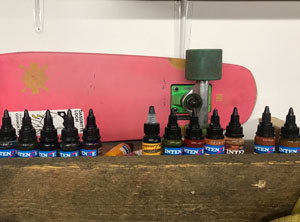 The Best Tattoo Ink 2024
The Best Tattoo Ink 2024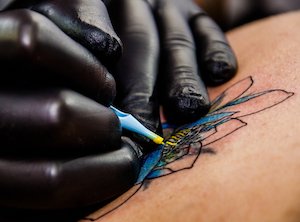 Tattooing Over Stretch Marks, Moles, Scars And Other Skin Conditions
Tattooing Over Stretch Marks, Moles, Scars And Other Skin Conditions 11 Best Fonts For Tattoos 2022
11 Best Fonts For Tattoos 2022 Advice For An Itchy Tattoo
Advice For An Itchy Tattoo
